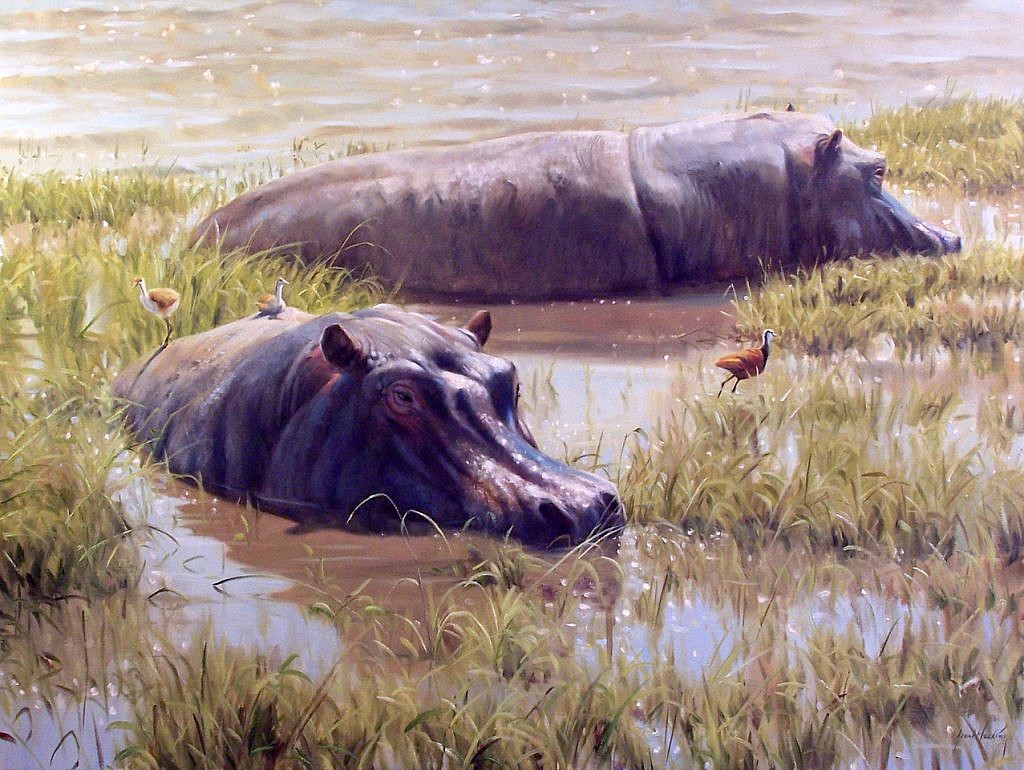
by Brooke Chilvers
I wish I’d collected the T-shirts I’ve seen over the years of Africa’s Big Five species that picture an obviously Asian elephant and even a tiger. One, perhaps a leftover from the 1960s, included a bear, likely inspired from Bruno the Bear in the TV series Daktari, which takes place in an Americanized East Africa. (If you must know, Clarence the Cross-eyed Lion died at age seven in 1969, and Bruno went on to be the star of Gentle Ben.) Online, there’s one that involves a gnu.
No way nature artist Grant Hacking, born in Johannesburg, South Africa in 1964, could ever get the Big Five wrong. His childhood was filled with excursions scouting for wildlife with his parents, both professional artists, in Kruger Park and the Great Zimbabwe ruins. His mother once armed herself with a frying pan, thinking to chase away an errant dog that turned out to be a leopard, and real-life black mambas and creepy scorpions inhabit Grant’s memory bank.

Early tagged “school artist,” Grant was responsible for painting class displays, posters, and backdrops for plays. In high school, he was commissioned to produce artworks for the building’s hallways and offices. In the army, during his two years of mandatory service, Hacking restored old works in the South African National War Museum, as well as producing original paintings of important military figures and moments in history.
“Everything I did led me to painting. It was never a question of being artist. I just am,” says Grant who, at age 25, accompanied his artwork for an exhibition at the National Wildlife Federation in Washington, D.C. This led to a year exploring America, which led to another, eventually becoming seven years. A return visit to a very different South Africa than the one he’d left behind convinced him to make the States his permanent home.
Today, African subjects constitute about a third of the artist’s wildlife output from his home and studio in New Hampshire ski country. North American elk, bears, moose, and wolves make up the rest, although he also paints more abstract Maine coastal scenes and White Mountain landscapes. His tightly painted birds, selected for their gorgeous forms and colors, flourish in front of impressionistic backgrounds.

Wildlife and nature art collectors know Hacking from the annual Southeastern Wildlife Exposition in Charleston, S.C., where he has won many awards and was Featured Artist in 2015. And, he’s a familiar face in the hunting community through his years of exhibiting at Safari Club International (SCI) conventions. His convincing, action-packed images have appeared many times on the covers of SCI’s Safari magazine and Gray’s Sporting Journal, along with Terry Wieland’s 2015 article, “Lupine Schizo.”
Having just returned to real life from a long-delayed, twice-cancelled family photographic safari in northern Tanzania, I was not ready to give up my visions of elephants and antelopes. So I turned to Hacking’s old tusker shuddering with aggressiveness, to the pair of cheetahs he dares placing in front of an imaginary view of Mt. Kilimanjaro. “Ninety percent of the landscape in my paintings is made up in my head, even iconic ones, like the Tetons,” explains Hacking. But he is no stranger to more abstract scenery, enveloping his stampeding buffalo in clouds of dust, his wolves in Arctic breath.

Yet the artist respects two very different palettes that vary not so much according to season but rather to continent. His North American skies require more hues of manganese blue, a “clear and punchy azure blue,” and Windsor blue, “a grayish purplish blue.” Its landscapes require more greens and grays, while Africa calls for more tans, ochres, and lilacs. North American game requires more from his span of browns – burnt umber, raw sienna, yellow ochre light, and burnt sienna – because their colors are typically darker than African hides.
Although Grant taught himself to paint from studying the works of Robert Bateman, Guy Coheleach, John Seerey-Lester, and especially David Shepherd, for inspiration he turns to “everyone and to no one. Being influenced by other artists can make your life very hard. As I have grown in my art, I have learned to rely on my own work and skill.”

Rather than dealing with my outpouring of insipid safari photos that failed to make a point, Grant’s African artworks on his website helped prolong the drama and excitement of our time on safari. His Nile crocodile about to crunch a zebra might as well have been a scene from the great migration of wildebeest and zebras crossing the Mara River in Serengeti National Park. In addition to leopards hanging out in trees and families of elephants, I found the great Dagga Boys, black-maned lions, impala, hippos, Grant’s gazelle, even the dik-dik of our own African adventure in Serengeti, Tarangire, the Ngorongoro Crater, and Arusha National Parks.
Above all, I found the brazen dawns and cherished light of sundowners that bring me back over and over again to a continent I thought I’d sworn off for good.
Brooke Chilvers would like to thank Helen Angelides of McCallum Safaris (Safari Royal), Tanzania, for her professionalism, good judgment, and interminable patience in the organization of our 2022 Tanzania family photo safari.
